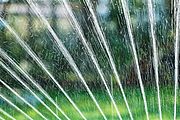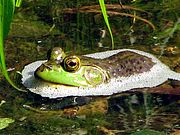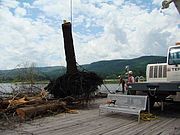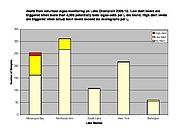Summer is here. Swimmers no longer need to brave the cold as the lake has warmed up over 700 F according to USGS gauges. The lake level, though still high, has receded well below flood stage. The first harvests of the gardens are in and gardeners need to turn their attention to weeding and watering.
Summer’s rising temperatures often coincide with rising water use. “Peak” water use describes the time of year when residential water use is at its highest due to an increase in outdoor water use, usually from late July through early August. The amount of water homeowners use to keep their lawns green or fill their backyard pools spikes during this season—to the tune of about four times as much water or more than the rest of the year. Some homes use as much as 3,000 gallons on a peak day, or the equivalent of leaving a garden hose running for nearly 8 hours. Read...
~ Step on it: Grass doesn’t always need water just because it’s hot out. Step on the lawn, and if the grass springs back, then it doesn’t need water. An inexpensive soil moisture sensor can also show the amount of moisture at the plant’s roots and discourage overwatering.
~ Time it right: It’s best to water lawns and landscapes in the early morning and late evening because significant amounts of water can be lost due to evaporation at other times of day.
~ Tune up your system: Inspect any irrigation systems you might have and check for leaks and broken or clogged sprinkler heads. Fix sprinkler heads that are broken or spraying on the street or driveway.
~ Give your hose a break: Sweep driveways, sidewalks, and steps rather than hosing them off. And don’t forget to check for leaks at your spigot connection and tighten as necessary.
~ Leave it long: Raise your lawn mower blade. Longer grass promotes deeper root growth, resulting in a more drought resistant lawn, reduced evaporation, and fewer weeds. Read...
In early July gray tree frogs can still be heard calling for mates, but by the end of the month bullfrog (jug-o-rum) and green frog (like a single tong from a banjo string) calls become more prominent. Tree frogs breed earlier in the season because they utilize vernal pools for laying eggs. The advantage of vernal pools is that they hold fewer predators. The disadvantage is that the eggs must hatch and the tadpoles mature before the pools dry up. In contrast bullfrog and green frog tadpoles breed in permanent bodies of water. Their tadpoles will spend at least one winter in the water before maturing. Read...
The Albany Times Union reported that this year’s lake flooding has led to some navigational challenges in the South Lake. Portions of the shoreline have broken off creating ‘islands’ as large as half an acre within navigation channels. In mid-July, the US Army Corps of Engineers used a floating crane to remove trees boulders and other debris from the lake at Maple Bend in Dresden; the result of a landslide reported on July 6th. Additional large segments of shoreline broke free and started floating in South Bay. According to Dave Winchell of the New York Department of Environmental Conservation, the largest of these segments has come to rest against a jetty leading to the South Bay fishing pier, while it is unclear what happened to the other pieces. Read...
LCC began its ninth season of our award-winning blue-green algae monitoring program in early July. Volunteer monitors take samples once per week at selected locations around the lake. The samples are then analyzed by the Rubenstein School of Natural Resources at the University of Vermont for the presence of blue-green algae and any toxins they might produce. The information generated is used to inform public health officials of any potentially toxic algae blooms on the lake. The monitoring season runs from the fourth of July through Labor Day.
Many thanks to all the volunteers that help us with monitoring efforts :Allan Carpenter (Red Rocks), Stephanie Kurchberg (North Beach), Catherine Brooks (Ferrisburgh Town Beach), Deb Diemand (Shoreham), Jon McBride and Amy Calkins (Begg’s Park), Bob Murphy (Willsboro Bay), Mary Simmers, Gerry Duprey, and Gerry O’Conner (Point Au Roche), Gary Molinski (Rouses Point), Doug Ward (North Hero State Park), Sally and Jim Brabham (Carry Bay), Larry and Jeannine Pratt (Pelots Bay), David Greenough (City Bay), Eric Wolinsky and Keith Peterson (St. Albans Bay Park), Kaylee Pollander (Maquam Shore), Martha Perry (Donaldson Point), Mike Roach (Shipyard), Bob Martell (Chapman Bay), Bill Magnus (Rock River and High Rocks). Read...





